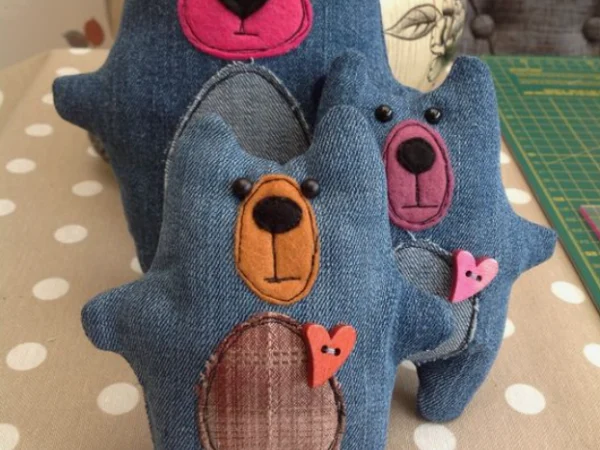Denim is a versatile and durable fabric that has become a fashion must-have. However, the denim manufacturing process has a serious impact on the environment. As sustainability becomes more of a concern, there is growing interest in finding ways to minimize the negative impacts of denim production and waste.
This article explores the benefits of recycled denim, highlighting its positive impact on the environment, the fashion industry, and the overall circular economy. And we will talk about from bellowing:
- The impact of denim production on the environment
- The concept of recycled denim:
- Benefits of Recycling Denim
- Practical Examples of Denim Recycling Initiatives
- Challenges and Solutions in Denim Recycling
The Impact of Denim Production on the Environment
- Water consumption and pollution
The manufacturing process of denim has a significant impact on water resources. Cotton is the main material for denim production and its cultivation requires a lot of water. According to the report of WWF, one kilogram of cotton will take about 20,000 liters of water. Additionally, the dyeing and finishing processes of denim manufacturing require large amounts of water, leading to water pollution as the chemicals used in these processes contaminate local water supplies. Excessive water use and pollution associated with denim manufacturing highlight the urgent need for sustainable practices to reduce these environmental impacts.
- Energy Consumption and Greenhouse Gas Emissions
The manufacture of denim consumes a lot of energy, resulting in greenhouse gas emissions. The fashion industry, including denim production, accounts for a large portion of global carbon emissions. According to the data of the Ellen MacArthur Foundation, the carbon emissions of the fashion industry account for about 10% of global carbon emissions. The production of cotton denim and its energy-intensive processes such as spinning, weaving, dyeing, and finishing add to the carbon footprint. Additionally, the use of synthetic dyes and chemical treatments has further raised concerns about pollution and toxins released into the air and water during denim production. Finding ways to reduce energy consumption and transition to cleaner sources of energy is critical to mitigating the environmental impact of denim manufacturing.
- The use of pesticides in cotton cultivation
Cotton is the main component of Denim, and is one of the crops that use more pesticides in the world. According to data from the Environmental Fund, denim is mainly made with cotton. And cultivation accounts for 16% of the global total, and the use of herbicides accounts for 7%. These pesticides not only endanger the environment but also pose a threat to the health of farmers in growing regions. Excessive use of pesticides in denim farming can lead to soil degradation, water pollution, and loss of biodiversity. Adopting organic cotton growing methods or supporting initiatives that promote the responsible use of pesticides can help reduce the environmental impact of denim manufacturing.
- Landfill waste of discarded denim
As fashion trends change and consumer demands change, tons of denim end up in landfills every year. Denim is not biodegradable and can spend hundreds of, years to break down. The accumulation of discarded denim in landfills exacerbates waste management problems and leads to soil and water pollution. Finding ways to minimize landfill waste of discarded denim is critical to reducing the environmental impact of denim manufacturing. Recycling initiatives and upcycling methods can play an important role in diverting denim from landfills and giving it new life, reducing the environmental burden of denim waste.
In conclusion, the environmental impact of denim manufacturing is enormous and requires urgent action. Water consumption and pollution, energy consumption and greenhouse gas emissions, the use of pesticides in cotton farming, and landfill waste of discarded denim are key areas that need to be addressed. To contribute to a more sustainable future, the Denim industry can adopt more sustainable practices, such as reducing its footprint in the environment. Manufacturers, brands, consumers, and policymakers must work together to develop and promote more environmentally friendly solutions to ensure the long-term feasibility of Denim production and minimize its negative impact on the environment.
The Concept of Recycled Denim
- Definition and processes involved
Recycling denim involves going through a series of processes to convert old or discarded denim garments into new products. The aim is to minimize waste and maximize reuse of denim material. The first step of recycling is to collect denim clothing, which can be obtained from various sources, such as donation centers, second-hand stores, and even directly from consumers. Once collected, denim garments are sorted by their condition, color, and fabric type.
After sorting, the denim garments are washed and prepared for the recycling process. This may involve removing buttons, zippers, and other non-denim components. These garments are then usually ripped into smaller pieces, which are converted into fibers or yarns that can be used to make new denim products. This shredded denim can then be spun into yarn, woven into the fabric, or can be blended with other materials to create innovative denim blends with enhanced properties. Denim can be recycled to create various new Denim products.
Like producing new jeans, jackets, shorts, and skirts, as well as accessories such as bags, shoes, or interior decorations. Recycled Denim can be used alone or mixed with other sustainable fibers such as Organic cotton or recycled polyester to improve its durability and sustainability.
- Importance of recycling in a circular economy
Recycled denim plays a vital role in the circular economy concept, which aims to eliminate waste and keep the material in a cycle of continuous reuse. The fashion industry, including denim products, is notorious for its waste, with a large number of clothing ultimately thrown into landfills. By adopting recycling principles, the fashion industry can move towards a more sustainable and circular approach.
One of the main benefits of recycled denim is a reduced environmental impact. By reusing denim material, the need for virgin resources such as cotton, water, and energy will be greatly reduced. Recycling denim also helps address the landfill waste problem, enabling discarded denim garments to be turned into new products rather than contributing to the growing textile waste problem. Additionally, there are economic advantages to recycling denim.
The recycling industry creates jobs in the collection, sorting, and processing of denim garments. By supporting and promoting recycling initiatives, local economies can thrive, creating sustainable employment opportunities for the community. Plus, recycled denim helps reduce carbon emissions. Producing new denim from virgin materials requires a lot of energy, which often comes from non-renewable sources. By recycling denim, energy consumption, and associated greenhouse gas emissions can be reduced, thereby reducing the carbon footprint.
Why Is Denim a Good Fabric to Recycle?
Why Is Denim a Good Fabric to Recycle? So we have to talk about the benefits of Recycling Denim.

- Reduction of Environmental Impact
One of the main benefits of recycling Denim is to reduce the impact on the environment. Recycling denim helps conserve precious water resources, which are severely affected by conventional denim production. In traditional denim manufacturing, vast amounts of water are used in various stages, including growing cotton, dyeing the fabric, and finishing processes. By recycling denim, the need for new cotton production is minimized, resulting in reduced demand for water-intensive cotton farming.
Furthermore, recycling denim leads to decreased energy consumption and emissions. The production of new denim from virgin materials requires substantial amounts of energy, contributing to greenhouse gas emissions. In contrast, recycling denim saves energy by avoiding the energy-intensive processes involved in producing new denim fabrics. By reusing denim materials, the carbon emissions associated with these manufacturing processes are significantly reduced.
Another environmental benefit of recycling denim lies in the reduced use of pesticides. Cotton, the primary material used in denim production, is often heavily sprayed with pesticides to combat pests and diseases. By recycling denim, the demand for new cotton is reduced, subsequently lowering the need for pesticide use. This reduction in pesticide utilization has positive implications for both environmental and human health.
Moreover, recycling denim helps divert denim garments from landfills. Every year, a large amount of textile waste is landfilled, occupying valuable space and causing environmental pollution. By recycling denim, these garments are given a new lease on life, preventing them from becoming waste. This not only reduces landfill waste but also helps to save the resources originally used to produce new Denim.
- Protecting the fashion industry
Recycling Denim is not only good for the environment but also helps protect the fashion industry. By promoting sustainable fashion practices, recycling denim encourages the industry to adopt responsible and ethical approaches to production. This shift towards sustainability is becoming increasingly important as consumers demand transparency and eco-conscious choices.
In addition to promoting sustainable practices, recycling denim creates new business opportunities. Recycling facilities, collection centers, and manufacturers specializing in recycled denim products can establish themselves in the market. This not only stimulates economic growth within the recycling industry but also provides entrepreneurs and artisans with the chance to innovate and create unique denim products.
Furthermore, recycling denim has the potential to revitalize local economies. By establishing recycling facilities and employing local workers, communities can benefit from job creation and economic development. This can lead to greater stability and prosperity, particularly in regions that have previously relied on traditional denim manufacturing but have faced economic challenges due to globalization.
- Ethical Considerations
Ethical considerations are another important aspect of recycling denim. By recycling denim, we contribute to the creation of safer working conditions for denim workers. In many countries where denim production occurs, labor conditions can be harsh and hazardous. By reducing the demand for new denim production through recycling, the industry can help alleviate the pressure on denim workers and encourage the improvement of their working conditions.
Additionally, recycling denim supports fair trade practices in denim supply chains. The fashion industry, including denim manufacturing, has often faced criticism for exploitative labor practices and unfair wages. By embracing recycling initiatives, the industry can take a step towards fair trade and ensure that the workers involved in the recycling process are treated equitably and receive just compensation for their labor.
In conclusion, recycling denim brings forth numerous benefits. It reduces the environmental impact by conserving water resources, lowering energy consumption and emissions, reducing pesticide use, and diverting denim from landfills. It also plays a crucial role in protecting the fashion industry by promoting sustainable development, creating new business opportunities, and revitalizing the local economy. Moreover, recycling denim addresses ethical considerations such as improving working conditions for denim workers and fostering fair trade practices in the industry. By embracing the concept of recycling denim, we pave the way for a more sustainable, responsible, and ethical fashion industry.
Practical Examples of Denim Recycling Initiatives
- Upcycling denim into new garments
One practical example of denim recycling is the process of upcycling denim into new garments. Instead of discarding old denim jeans or jackets, innovative designers and artisans are finding creative ways to transform these materials into unique and fashionable pieces. Through cutting, reassembling, and adding embellishments, upcycled denim garments are given a new lease on life, reducing the need for new denim production. This not only saves resources but also creates a unique sustainable fashion item.
- Collaboration with fashion brands and designers
Denim recycling initiatives often involve collaborations between recycling facilities or organizations and fashion brands or designers. By partnering with established brands, denim recycling can gain wider recognition and reach a larger audience. Fashion brands can integrate recycled denim materials into their collections, creating new and sustainable products for consumers. These collaborations catalyze change within the fashion industry, promoting a shift towards more environmentally conscious and responsible practices.

- Community-led denim recycling projects
Community-led denim recycling projects are another practical example of denim recycling initiatives. In these projects, community members come together to collect, sort, and process denim garments for recycling. These grassroots efforts are often driven by local organizations, schools, or community centers that recognize the importance of reducing textile waste. Community members are encouraged to donate their unused or unwanted denim items, which are then processed into recycled fibers or repurposed for various applications in the local community. These not only contribute to sustainable development but also cultivate a sense of shared responsibility and participation within the community.
Challenges and Solutions in Denim Recycling
- Technological limitations
One of the challenges in denim recycling is the technological limitations associated with processing and transforming denim materials. Denim, especially its indigo dye, can be difficult to separate from cotton fibers during the recycling process. However, advancements in technology, such as innovative dye removal techniques and fabric shredding methods, hold promising solutions to address these limitations. Continued research and development in this field are crucial for enhancing the efficiency and effectiveness of denim recycling technologies.
- Consumer awareness and participation
Another challenge in denim recycling is the lack of consumer awareness and participation. Many individuals are unaware of the environmental impact of discarded denim and the potential for recycling. Increasing awareness through education campaigns, social media platforms, and collaborations with influencers can help promote the importance and benefits of denim recycling. Encouraging consumer participation through easily accessible donation and collection centers can also facilitate the recycling process and increase engagement from the public.
- Integration of recycled denim into the fashion industry
Integrating recycled denim into the fashion industry presents challenges as well. Designers and brands need to ensure that the quality, aesthetic, and functionality of recycled denim meet the expectations of consumers. Moreover, establishing reliable supply chains for recycled denim materials, and creating standardized production processes are necessary steps toward seamless integration. The fashion industry can collaborate with recycling facilities to develop guidelines and certifications that guarantee the authenticity and sustainability of recycled denim products, thus building trust and providing consumers with more sustainable fashion options.
Conclusion
Denim recycling offers a multitude of benefits, from reducing textile waste and conserving resources to promoting sustainable fashion practices.
Individuals and businesses need to support denim recycling initiatives by donating unwanted denim, collaborating with recycling facilities, and choosing products made from recycled denim. By embracing denim recycling, we contribute to a more sustainable, responsible, and ethical fashion industry.
In ZEVA DENIM, it has always maintained the concept of focusing on sustainable development and environmental protection from the beginning of material selection.
We produce eco-friendly denim fabrics from recycled cotton, recycled polyester fibers, and biodegradable fibers such as Tencel and Gracell.
You can click the Sustainable & Eco-Friendly denim fabric to learn more!





